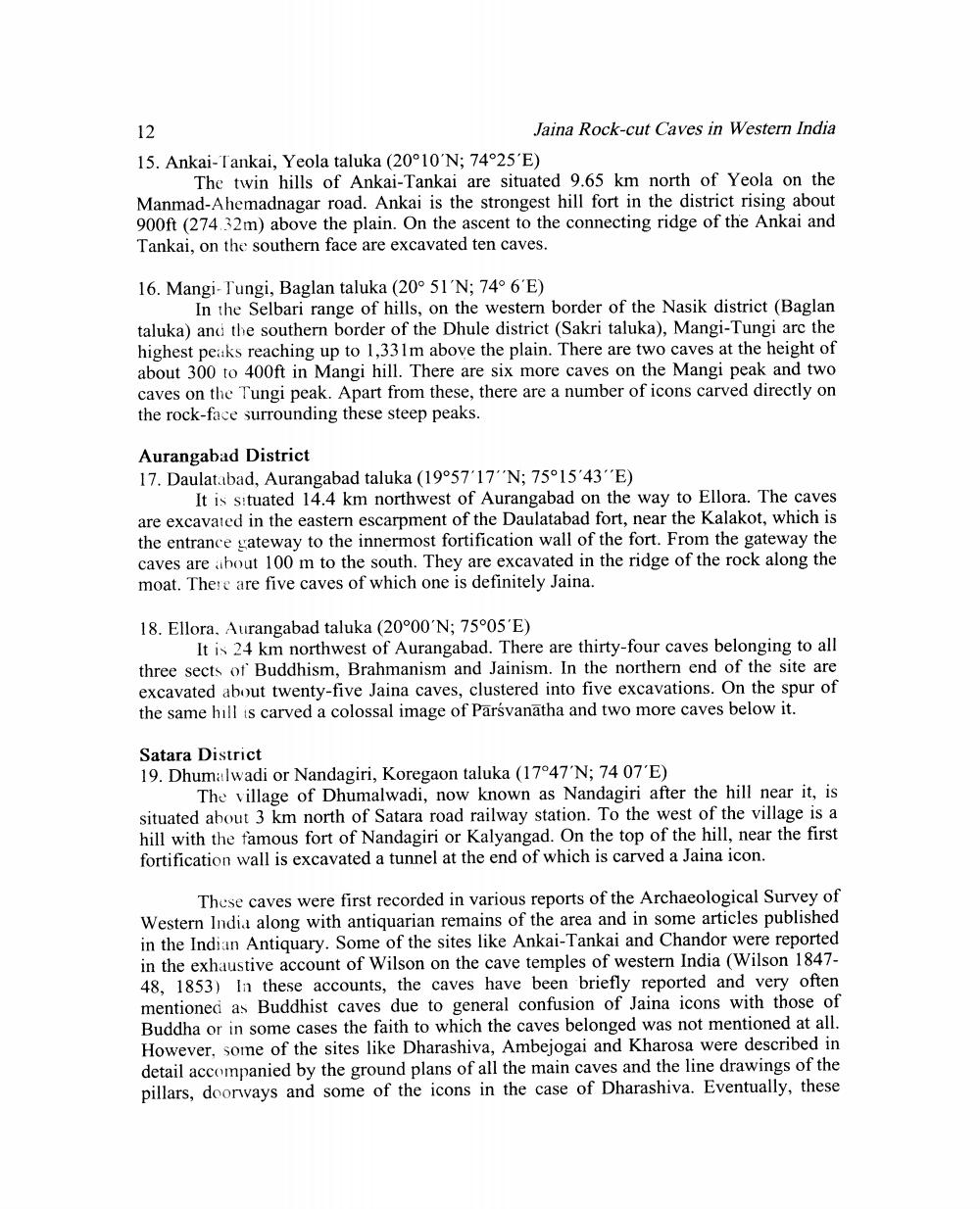________________
Jaina Rock-cut Caves in Western India
12
15. Ankai-Tankai, Yeola taluka (20°10'N; 74°25′E)
The twin hills of Ankai-Tankai are situated 9.65 km north of Yeola on the Manmad-Ahemadnagar road. Ankai is the strongest hill fort in the district rising about 900ft (274.32m) above the plain. On the ascent to the connecting ridge of the Ankai and Tankai, on the southern face are excavated ten caves.
16. Mangi Tungi, Baglan taluka (20° 51'N; 74° 6 E)
In the Selbari range of hills, on the western border of the Nasik district (Baglan taluka) and the southern border of the Dhule district (Sakri taluka), Mangi-Tungi arc the highest peaks reaching up to 1,331m above the plain. There are two caves at the height of about 300 to 400ft in Mangi hill. There are six more caves on the Mangi peak and two caves on the Tungi peak. Apart from these, there are a number of icons carved directly on the rock-face surrounding these steep peaks.
Aurangabad District
17. Daulatabad, Aurangabad taluka (19°57'17 N; 75°15'43"E)
It is situated 14.4 km northwest of Aurangabad on the way to Ellora. The caves are excavated in the eastern escarpment of the Daulatabad fort, near the Kalakot, which is the entrance gateway to the innermost fortification wall of the fort. From the gateway the caves are about 100 m to the south. They are excavated in the ridge of the rock along the moat. There are five caves of which one is definitely Jaina.
18. Ellora, Aurangabad taluka (20°00'N; 75°05'E)
It is 24 km northwest of Aurangabad. There are thirty-four caves belonging to all three sects of Buddhism, Brahmanism and Jainism. In the northern end of the site are excavated about twenty-five Jaina caves, clustered into five excavations. On the spur of the same hill is carved a colossal image of Parsvanatha and two more caves below it.
Satara District
19. Dhumalwadi or Nandagiri, Koregaon taluka (17°47'N; 74 07′E)
The village of Dhumalwadi, now known as Nandagiri after the hill near it, is situated about 3 km north of Satara road railway station. To the west of the village is a hill with the famous fort of Nandagiri or Kalyangad. On the top of the hill, near the first fortification wall is excavated a tunnel at the end of which is carved a Jaina icon.
These caves were first recorded in various reports of the Archaeological Survey of Western India along with antiquarian remains of the area and in some articles published in the Indian Antiquary. Some of the sites like Ankai-Tankai and Chandor were reported in the exhaustive account of Wilson on the cave temples of western India (Wilson 184748, 1853) In these accounts, the caves have been briefly reported and very often mentioned as Buddhist caves due to general confusion of Jaina icons with those of Buddha or in some cases the faith to which the caves belonged was not mentioned at all. However, some of the sites like Dharashiva, Ambejogai and Kharosa were described in detail accompanied by the ground plans of all the main caves and the line drawings of the pillars, doorways and some of the icons in the case of Dharashiva. Eventually, these




